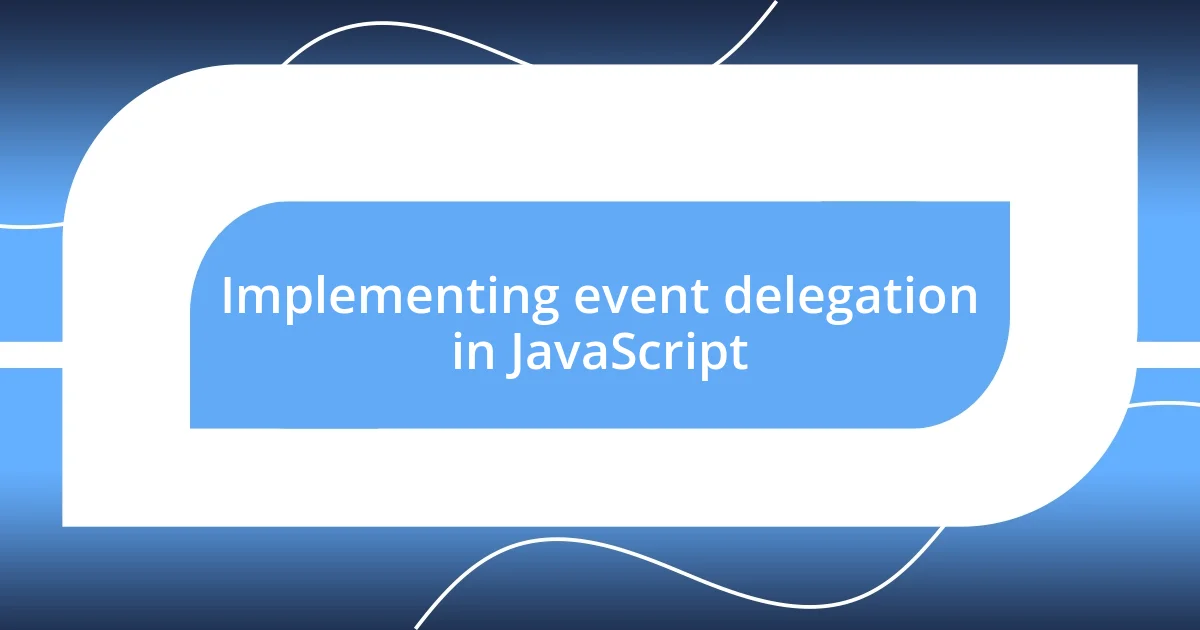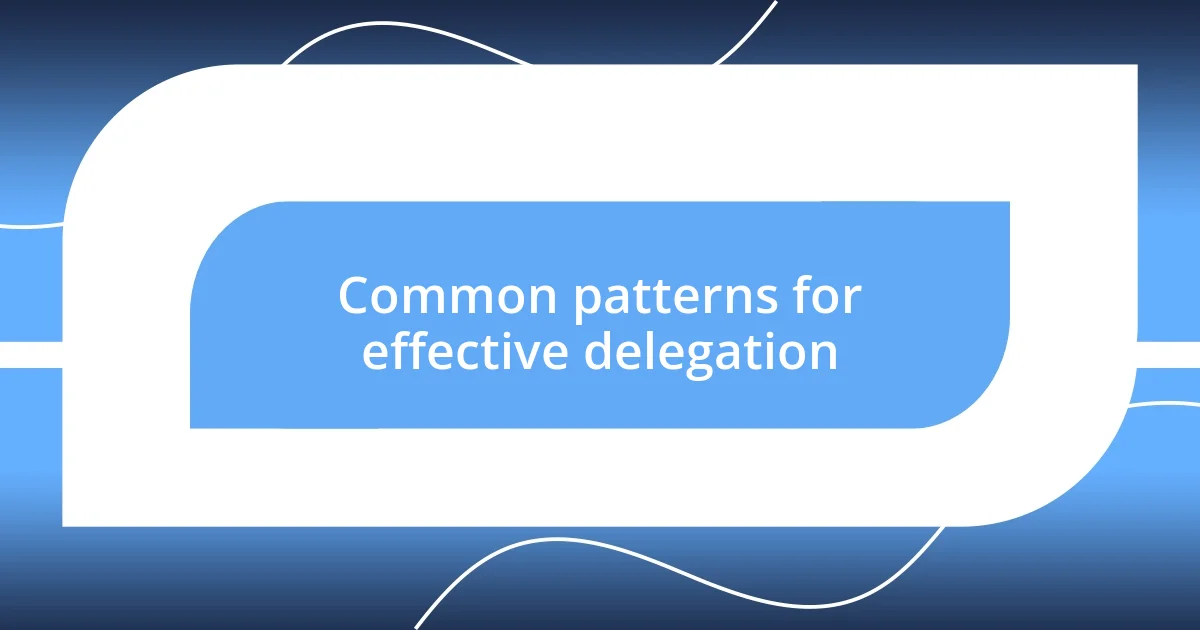Key takeaways:
- Event delegation allows developers to simplify event management by using a single listener on a parent element, improving performance and scalability.
- Implementing event delegation enhances code organization and maintainability, especially in dynamic applications with frequently changing content.
- Debugging event delegation requires attention to detail and understanding event flow to ensure that events are triggered appropriately without unnecessary complications.

Understanding event delegation basics
Event delegation is a powerful concept that allows developers to manage events more efficiently in their applications. By registering a single event listener on a parent element, we can capture events that bubble up from child elements. I remember the first time I implemented this strategy; it felt like I had unlocked a whole new layer of functionality in my app. Have you ever faced the chaos of numerous listeners? It’s exhausting!
This approach not only simplifies code but also enhances performance, especially when dealing with dynamic content. For instance, when I built a to-do list app, I realized that I could add new tasks without reattaching event listeners each time. Instead, I simply listened on the parent element, allowing me to focus on enhancing features rather than debugging repetitive code. Have you thought about how much time this could save you?
By understanding the basics of event delegation, I found myself reducing memory consumption and improving app responsiveness. It truly shifted my perspective on event handling. Who knew a simple technique could have such a profound impact on performance? It’s like seeing the bigger picture after spending too much time on details, don’t you think?

Benefits of using event delegation
Using event delegation has been a game changer in my development journey. One immediate benefit I noticed was the significant reduction in the number of event listeners I had to manage. By attaching a single listener to a parent element, I felt a sense of relief from the clutter. It allowed me to better organize my code, making it cleaner and easier to read. Have you ever strived for that level of simplicity in your own projects?
Another advantage that stood out during my work on a complex web application was enhanced performance. With event delegation, events triggered from dynamically created elements are automatically caught by the parent. This became crucial when I had to load new content without bogging down the app’s performance. I vividly remember a moment when a feature I thought would slow everything down actually sailed smoothly, thanks to this approach. It was a thrilling realization that I could prioritize user experience without sacrificing speed!
Lastly, I discovered that event delegation significantly boosts scalability. When expanding my app’s features, I could seamlessly integrate new functionalities without overhauling existing listeners. It’s almost like having a strong foundation that supports adding new stories to a building without compromising its structure. The joy of effortlessly scaling my app filled me with motivation to innovate further. How does the idea of growth resonate with you?
| Benefit | Description |
|---|---|
| Code Simplicity | Reduces clutter by minimizing event listeners needed. |
| Performance Enhancement | Improves performance by capturing events from dynamic elements. |
| Scalability | Allows for easy integration of new features without redesigning event handling. |

Implementing event delegation in JavaScript
Implementing event delegation in JavaScript is quite straightforward, and I remember the excitement of experiencing that “aha!” moment when I first tried it. The technique involves attaching a single event listener to a parent element rather than multiple listeners on each child. This way, when an event occurs, you can utilize the bubbling phase to capture it. It was like finding a shortcut to streamline my app’s interactivity. I never looked back after realizing how much cleaner my code became.
Here’s a simple guide to implement event delegation effectively:
- Select the Parent: Choose an element that will wrap around the dynamic content. This could be a list or a container.
- Attach Event Listener: Use
addEventListeneron the parent for the desired event, likeclick. - Identify Target: In the event handler, determine the source of the event (the child element) using
event.target. - Perform Action: Execute your desired functionality based on the target element’s attributes.
When I first set this up in a photo gallery app, the ease of adding new images without recalibrating the event logic was genuinely exhilarating. It felt like I had finally tamed the chaos of my earlier code, and I couldn’t help but smile at the improvement in both organization and ease of maintenance.

Common patterns for effective delegation
When it comes to effective delegation, I’ve found that a common pattern is to pair it with event filtering. This means setting up your event listener on a parent and then narrowing down the specific target within the handler. I remember a time when I built an interactive to-do list. Initially, I just responded to clicks everywhere in the list, but I quickly realized that checking event.target allowed me to handle checkboxes and delete buttons specifically. It felt rewarding to refine my code while improving usability.
Another effective pattern I often utilize is leveraging delegation for multiple event types. Instead of writing separate listeners for different interactions, I’ll attach a single listener and handle the various events within one function. I recall working on a multi-step form where I had various input types that required validation. Consolidating all those checks into one handler simplified my code immensely. It’s almost like finding harmony in what should have been chaos. Have you ever experienced that sense of clarity?
Lastly, I prioritize event delegation in dynamic interfaces, especially when building components that frequently change. For example, I had a real-time chat application where users could join or leave rooms frequently. By using delegation, I ensured that my click events for sending messages or interacting with other users were seamlessly managed. It felt like a revelation; I could focus on enhancing the user experience without worrying about event listeners piling up. How liberating does that sound?

Optimizing performance with event delegation
When optimizing performance with event delegation, the effects are especially pronounced when it comes to memory management. I once worked on a robust e-commerce platform where adding listeners to every single product card drastically bogged down the application. By shifting to a single parent listener, I reduced memory usage that truly seemed to turbocharge the responsiveness of the UI. Have you ever felt that moment when everything just clicks, and suddenly the app feels fast and nimble? It’s satisfying, to say the least.
Another benefit I’ve noticed is improved maintainability. While building a dashboard for monitoring analytics, I remember initially cluttering the code with individual event listeners for each widget. However, when I transitioned to event delegation, not only did it streamline my logic, it also made future updates easier to roll out. Suddenly, all I had to consider was the parent container rather than navigating through a maze of listeners. How much simpler does maintaining your code feel when you’ve minimized the clutter?
Moreover, event delegation shines in applications that require dynamic content loading. I developed a news aggregator app that displayed articles as users scrolled. By implementing delegation, I ensured that even as new articles were added, the existing events remained intact. It was like watching my code dance seamlessly, adapting without breaking a sweat. Can you imagine the stress that comes from worrying about losing functionality with every new element added? That’s a relief I wish for every developer to experience!

Debugging event delegation issues
Debugging event delegation issues can be a real head-scratcher at times. I recall a project where I set up delegation correctly, yet the events still didn’t fire as expected. After some digging, I realized I had made a simple oversight by using an incorrect selector in my delegate. It’s those moments of clarity that remind me how crucial attention to detail is. Have you ever encountered a bug that turned out to be due to something seemingly trivial? The relief of finding that fix can be incredibly satisfying.
Another challenge I’ve faced is ensuring that the delegated events are triggered only when appropriate. Once, I had a context menu that popped up on right-click, but I found it opening unexpectedly due to bubbling up from child elements. By adding a check for the event’s target, I could filter out unwanted triggers. It was a neat reminder of how much power lies in understanding the event flow. How often do we overlook those subtle nuances that can cause big headaches down the line?
Monitoring the context of your events is equally vital. I remember working on a game where player interactions would sometimes trigger unwanted events, like selecting a menu option while aiming. By employing event delegation smartly, I could differentiate between game actions and UI interactions, ensuring a smooth experience for players. It’s that fine-tuning that can make all the difference in user satisfaction. Isn’t it fascinating how a little extra effort in debugging can elevate your application’s usability?














